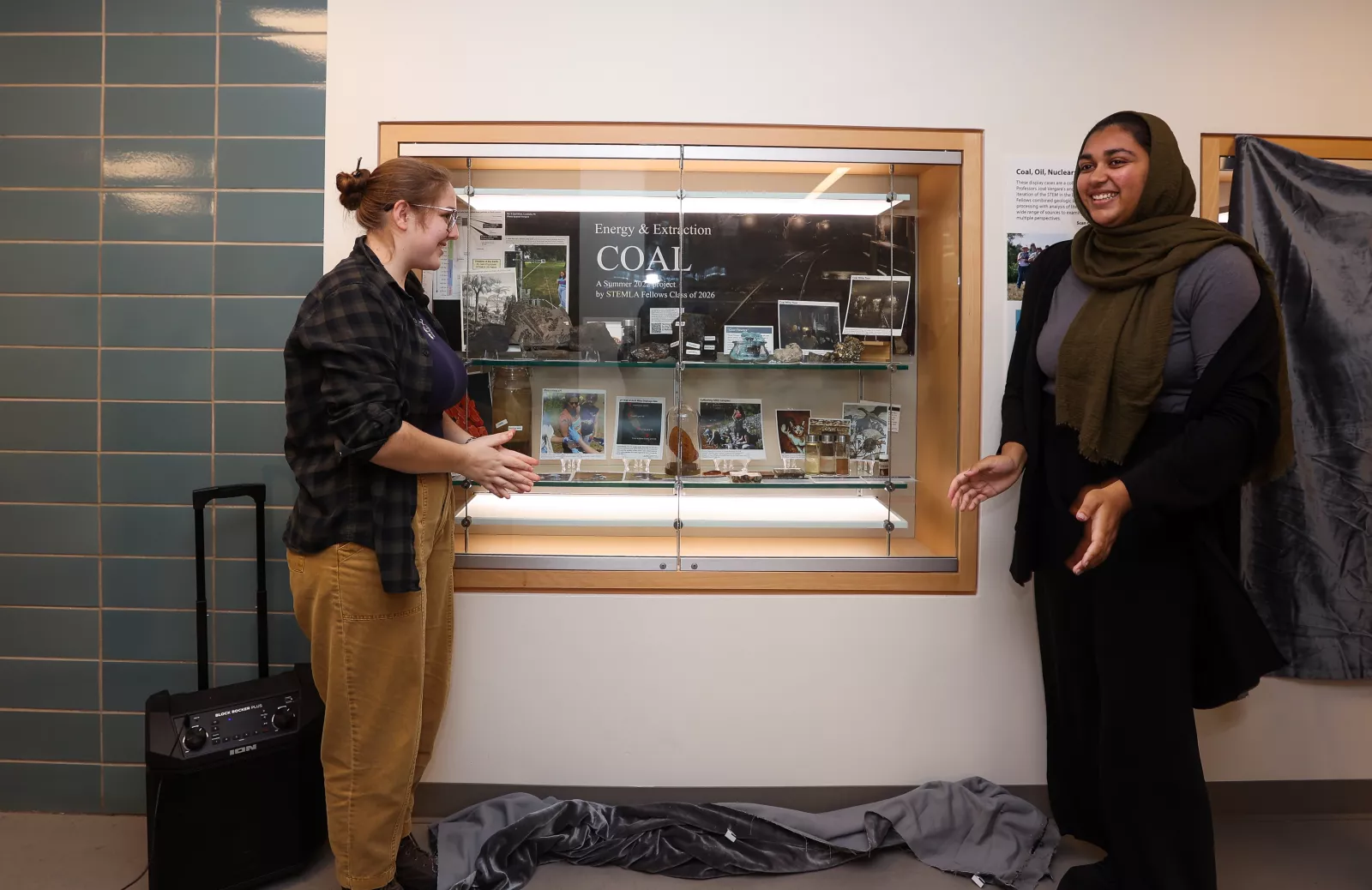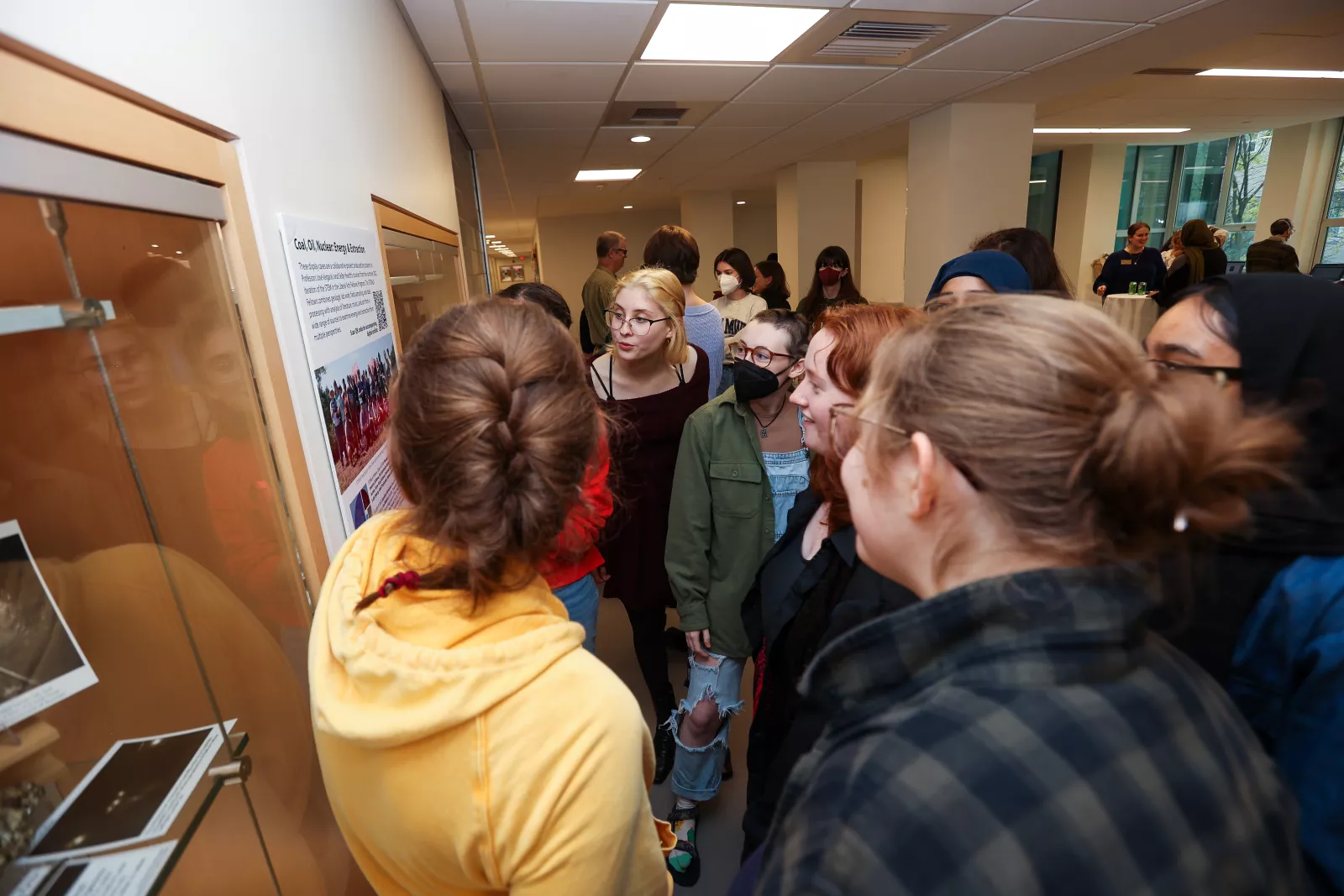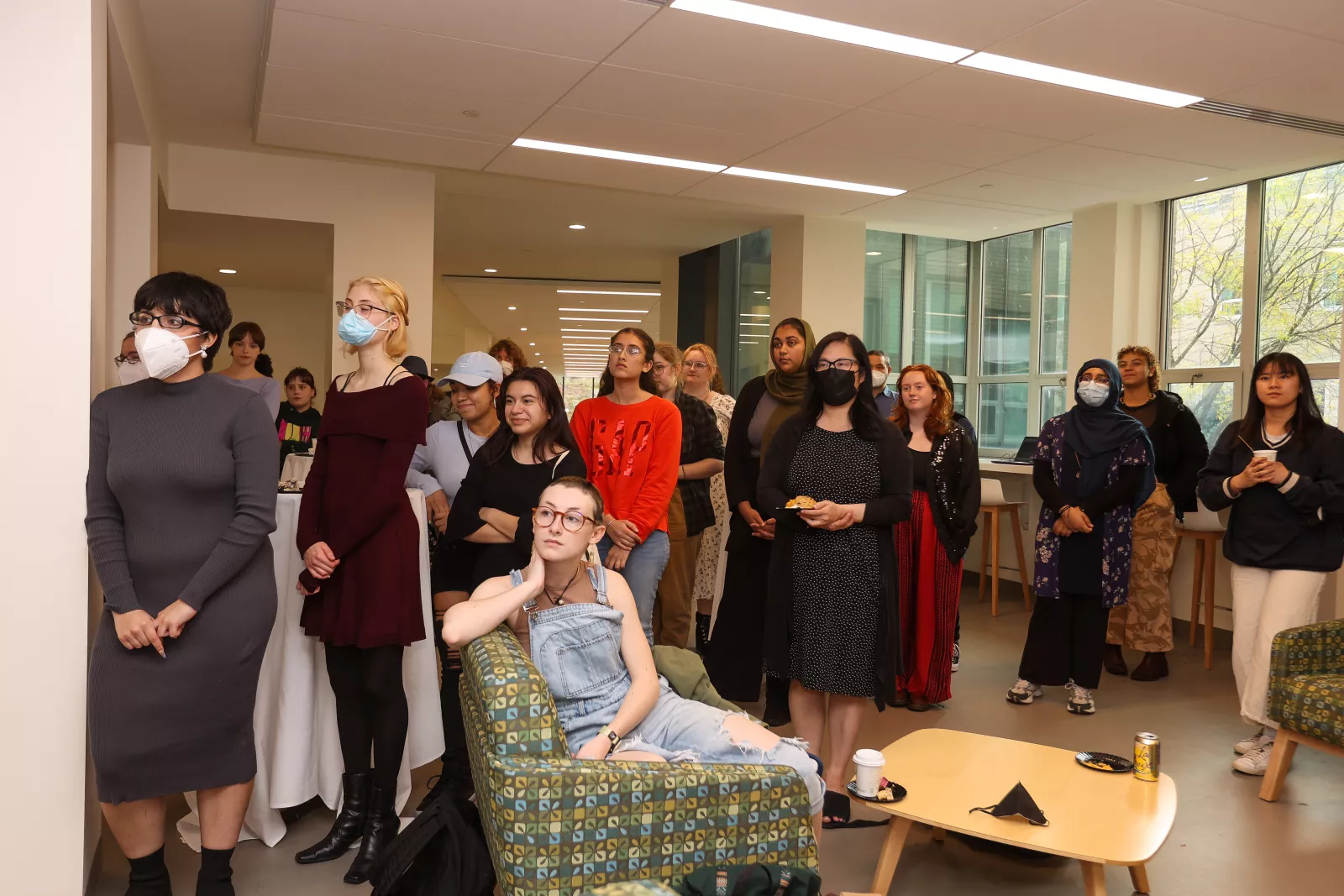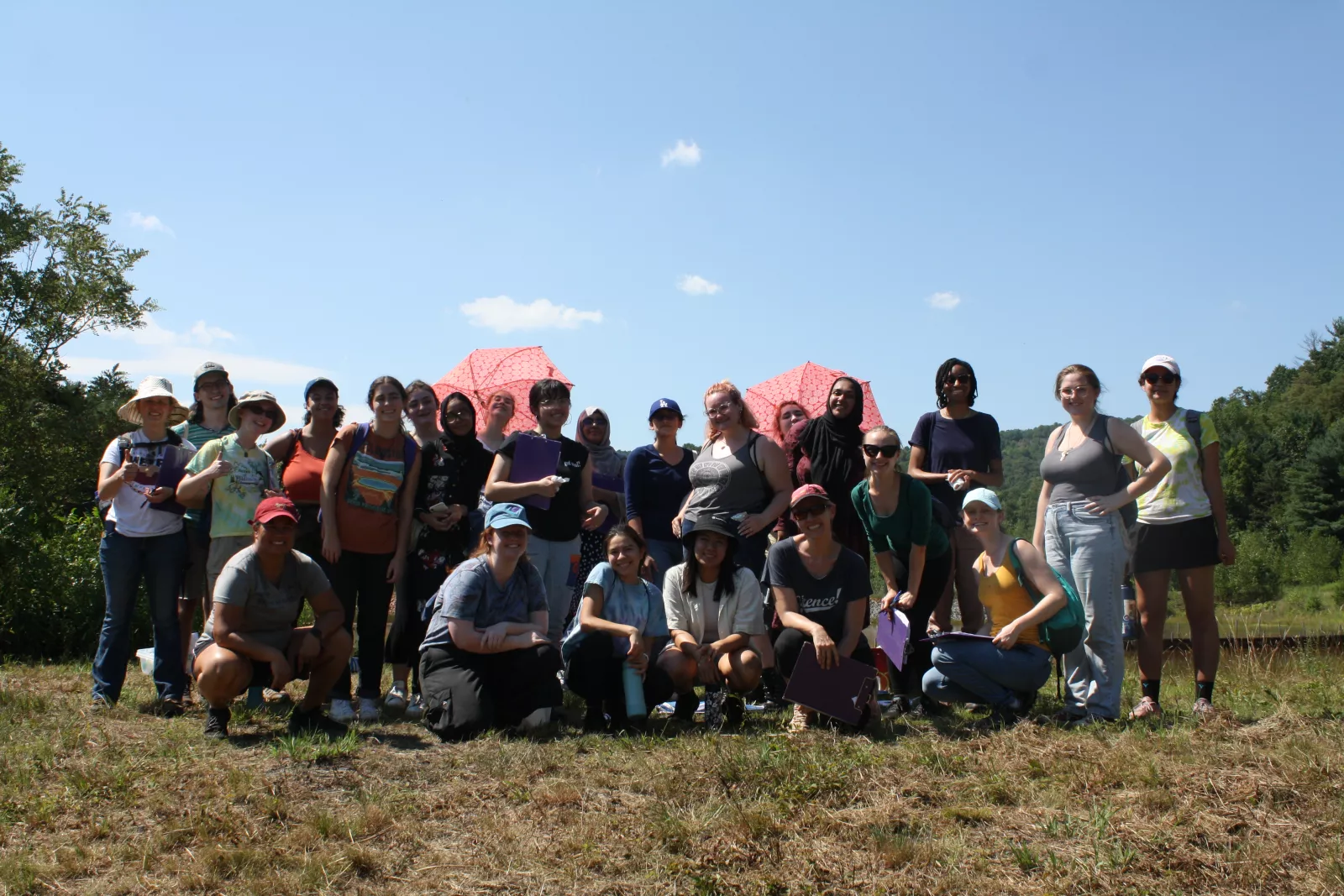
On Wednesday, October 26, fellows in the STEM in the Liberal Arts (STEMLA) Program showcased their work at a display and digital exhibit unveiling in Park Atrium.
STEMLA began its second year this summer and welcomed 18 new students into their 2022 cohort. For the 2022 theme of human and environmental impacts of energy, fellows took Geology of Energy and Extraction with Associate Professor of Geology Selby Hearth, and Oil, Coal, Nuclear: Narrative Afterlives with Assistant Professor of Russian José Vergara.
For the unveiling, fellows put together a physical display case of photos, geological specimens, 3D-printed items, and diagrams related to the courses and field trips they took that summer, as well as a digital exhibit that they had created. The physical display also included paintings students made using iron oxides collected from their trip to an acid mine remediation site.
At the event, first-year fellows Grace Trembath, Esenia Banuelos, Rezwana Sarder, and Rowan Killina shared about their summer experience, what they learned, and the impact the program had on them.
Attendees included fellows from all cohorts, STEMLA faculty mentors, anyone who had a role in building the program, and others interested in getting involved with STEMLA in the future.
STEMLA is a free, interdisciplinary college-transition and mentorship program designed for limited income undergraduate students with a stated interest in STEM. The STEMLA program aims to support students in their development of STEM identity, belonging, and career exploration through an immersive summer program, mentorship, and participation in research and conferences.
STEMLA’s leadership team is composed of faculty director Jennifer Skirkanich and coordinator Kelsey Obringer. Skirkanich, who also serves as senior biology lecturer and STEM director for Posse, wanted to create a program that would offer students comprehensive STEM support throughout their time at Bryn Mawr. She started building the program in the winter of 2019, and after a year of applying for grants, STEMLA officially launched in the summer of 2021. In addition to College support, STEMLA is funded by the Arthur Vining Davis Foundations and the National Science Foundation.
The first stage of STEMLA is a residential program where the fellows spend four weeks during the summer before their first year at Bryn Mawr receiving in-depth STEM courses and participating in field trips. Fellows receive a stipend for the summer, and the program covers all costs for their travel, food, and housing.
“The summer program allows students to find their own path in science and to establish a community for themselves of people they are personally connected to that have a vested interest in their success in science at Bryn Mawr,” says Skirkanich.
Students take a total of three courses over the summer; one quantitative reasoning course, and two courses related to the year’s theme. Quantitative Reasoning in STEM was co-taught by Visiting Instructor of Mathematics Daisy Sudparid and Senior Lecturer in Chemistry Lisa Watkins.
Selby Hearth’s course examined coal, oil, and nuclear energy, and how these materials formed, their geochemistry, and the environmental consequences of their extraction. The students also did lab work, hands-on geology activities, data analysis, and a field sampling project at an abandoned coal mine in the Pennsylvania Appalachians.
“Each student brought such unique perspectives and experiences—this is one of the things I love best about teaching at a small liberal arts college! None of them had a background in geology, but they all brought their excitement for biochemistry or botany or physics, and applied it to the ideas we were examining,” says Hearth.
José Vergara’s course focused on the human side of energy and extraction by examining how writers and artists around the world have responded to and portrayed the effects of coal, oil, and nuclear energy on communities whose stories are often neglected.
“From the coal mines of the U.S. and China to the Athabasca, the fellows brought both a critical eye and great empathy to our discussions. Teaching this class was truly thrilling. I was consistently impressed by the students’ enthusiasm, the inventive connections they made to Selby course, and the creativity they displayed in their final projects. Collaborating with this STEMLA cohort and my colleagues in these ways was, to me, an ideal example of interdisciplinary liberal arts education. I’m really looking forward to seeing what these students accomplish in the next four years—and beyond,” says Vergara.
In addition to their courses, STEMLA fellows participated in field trips, metacognition sessions, and meetings with Bryn Mawr STEM faculty. Students this year visited an acid mine remediation site in New Philadelphia, Pa., where they measured water pH levels and refined some of the polluted material to make their own paint.
Fellows also visited a coal mine in Coaldale, Pa., to learn about the lived experience of coal miners during the 20th century and the intergenerational practice of coal mining.
When not in classes or attending field trips, STEMLA fellows received visits from University of Pennsylvania graduate students to learn about the many different paths to a STEM career.
Mentorship is a key feature of the STEMLA program, and students take the summer to build relationships with different faculty members. The STEMLA faculty mentor program was carefully crafted to provide students with a faculty mentor they can work with throughout their Bryn Mawr undergraduate studies. Professors in the program go through training to learn about inclusive advising, meet with each other at least once a semester to discuss mentoring in the sciences, and share best practices to grow as mentors. In their senior years, fellows will become mentors themselves to younger students in the program.
The STEMLA program is designed to guide students well beyond their summer before entering Bryn Mawr. This fall semester, fellows are taking Scientific Thinking, a half-credit course designed to cover aspects that will help them be successful in introductory STEM courses. Fellows also receive funded opportunities for lab assistant positions, attendance at conferences, GRE test preparation, and research programs while at Bryn Mawr.
To learn more about STEMLA and eligibility to become a fellow, visit their webpage.


